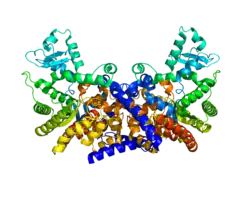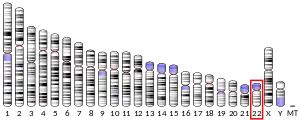| ADA2 | |||||||||||||||||||||||||||||||||||||||||||||||||||
|---|---|---|---|---|---|---|---|---|---|---|---|---|---|---|---|---|---|---|---|---|---|---|---|---|---|---|---|---|---|---|---|---|---|---|---|---|---|---|---|---|---|---|---|---|---|---|---|---|---|---|---|
 | |||||||||||||||||||||||||||||||||||||||||||||||||||
| |||||||||||||||||||||||||||||||||||||||||||||||||||
| Identifiers | |||||||||||||||||||||||||||||||||||||||||||||||||||
| Aliases | ADA2, ADGF, IDGFL, PAN, SNEDS, CECR1, cat eye syndrome chromosome region, candidate 1, adenosine deaminase 2, VAIHS | ||||||||||||||||||||||||||||||||||||||||||||||||||
| External IDs | OMIM: 607575 HomoloGene: 81852 GeneCards: ADA2 | ||||||||||||||||||||||||||||||||||||||||||||||||||
| |||||||||||||||||||||||||||||||||||||||||||||||||||
| |||||||||||||||||||||||||||||||||||||||||||||||||||
| |||||||||||||||||||||||||||||||||||||||||||||||||||
| |||||||||||||||||||||||||||||||||||||||||||||||||||
| Wikidata | |||||||||||||||||||||||||||||||||||||||||||||||||||
| |||||||||||||||||||||||||||||||||||||||||||||||||||
Cat eye syndrome critical region protein 1 is a protein that in humans is encoded by the CECR1 gene.[3][4]
This gene encodes a member of a subfamily of the adenosine deaminase protein family. The encoded protein may act as a growth factor and have adenosine deaminase activity. It may be responsible for some of the phenotypic features associated with cat eye syndrome. Two transcript variants encoding distinct isoforms have been identified for this gene.[4]
References
- 1 2 3 GRCh38: Ensembl release 89: ENSG00000093072 - Ensembl, May 2017
- ↑ "Human PubMed Reference:". National Center for Biotechnology Information, U.S. National Library of Medicine.
- ↑ Riazi MA, Brinkman-Mills P, Nguyen T, Pan H, Phan S, Ying F, Roe BA, Tochigi J, Shimizu Y, Minoshima S, Shimizu N, Buchwald M, McDermid HE (May 2000). "The human homolog of insect-derived growth factor, CECR1, is a candidate gene for features of cat eye syndrome". Genomics. 64 (3): 277–85. doi:10.1006/geno.1999.6099. PMID 10756095.
- 1 2 Hoppe, W.; Gassmann, J.; Hunsmann, N.; Schramm, H. J.; Sturm, M. (August 1975). "Comments on the paper "Relevance of three-dimensional reconstructions of stain distributions for structural analysis of biomolecules"". Hoppe-Seyler's Zeitschrift für Physiologische Chemie. 356 (8): 1317–1320. doi:10.1515/bchm2.1975.356.2.1317. ISSN 0018-4888. PMID 51816.
External links
- Human CECR1 genome location and CECR1 gene details page in the UCSC Genome Browser.
Further reading
- Charlab R, Valenzuela JG, Andersen J, Ribeiro JM (2001). "The invertebrate growth factor/CECR1 subfamily of adenosine deaminase proteins". Gene. 267 (1): 13–22. doi:10.1016/S0378-1119(01)00393-6. PMID 11311551.
- Footz TK, Brinkman-Mills P, Banting GS, et al. (2001). "Analysis of the cat eye syndrome critical region in humans and the region of conserved synteny in mice: a search for candidate genes at or near the human chromosome 22 pericentromere". Genome Res. 11 (6): 1053–70. doi:10.1101/gr.154901. PMC 311098. PMID 11381032.
- Strausberg RL, Feingold EA, Grouse LH, et al. (2003). "Generation and initial analysis of more than 15,000 full-length human and mouse cDNA sequences". Proc. Natl. Acad. Sci. U.S.A. 99 (26): 16899–903. Bibcode:2002PNAS...9916899M. doi:10.1073/pnas.242603899. PMC 139241. PMID 12477932.
- Ota T, Suzuki Y, Nishikawa T, et al. (2004). "Complete sequencing and characterization of 21,243 full-length human cDNAs". Nat. Genet. 36 (1): 40–5. doi:10.1038/ng1285. PMID 14702039.
- Collins JE, Wright CL, Edwards CA, et al. (2005). "A genome annotation-driven approach to cloning the human ORFeome". Genome Biol. 5 (10): R84. doi:10.1186/gb-2004-5-10-r84. PMC 545604. PMID 15461802.
- Gerhard DS, Wagner L, Feingold EA, et al. (2004). "The status, quality, and expansion of the NIH full-length cDNA project: the Mammalian Gene Collection (MGC)". Genome Res. 14 (10B): 2121–7. doi:10.1101/gr.2596504. PMC 528928. PMID 15489334.
- Zavialov AV, Engström A (2006). "Human ADA2 belongs to a new family of growth factors with adenosine deaminase activity". Biochem. J. 391 (Pt 1): 51–7. doi:10.1042/BJ20050683. PMC 1237138. PMID 15926889.
- Otsuki T, Ota T, Nishikawa T, et al. (2007). "Signal sequence and keyword trap in silico for selection of full-length human cDNAs encoding secretion or membrane proteins from oligo-capped cDNA libraries". DNA Res. 12 (2): 117–26. doi:10.1093/dnares/12.2.117. PMID 16303743.
This article is issued from Wikipedia. The text is licensed under Creative Commons - Attribution - Sharealike. Additional terms may apply for the media files.


